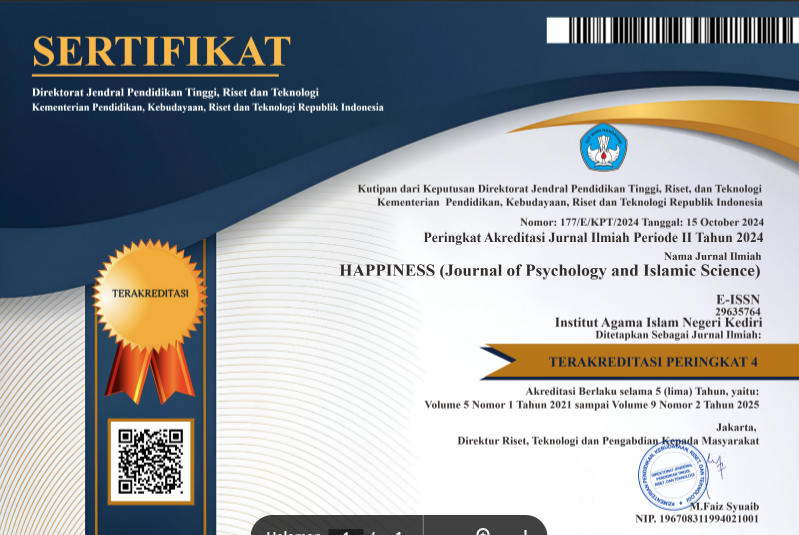Studi Komparasi antara Body Image Siswa Laki-Laki dan Siswa Perempuan Di Asrama (A Comparative Study Between the Body Image of Male and Female Students in Dormitories)
DOI:
https://doi.org/10.30762/happiness.v8i1.2443Keywords:
Body image, male students, female studentsAbstract
This study aims to: (1) know the level of body image of male and of female students in Dormitory. (2) Knowing whether there is a difference between the body image of male students in Daarul Ilmi Dormitory MAN 2 Kota Kediri. This research uses a quantitative approach with a comparative type. The sampling technique used in this study with a simple random sampling technique. The population in this study amounted to 168 students of Daarul Ilmi Dormitory, MAN 2, Kediri City, with 84 male students and 84 female students. This research data collection technique uses a questionnaire. The instrument used to determine student body image is a body image scale with reference to Cash's theory, compiled by the researcher himself. The data analysis for this research is a Mann-Whitney U Test comparative analysis with the help of IBM SPSS Statistic 25.0 for Windows software. The results of this study show: (1) the level of body image of male students at Daarul Ilmi Dormitory MAN 2 Kediri City is in the high category with a percentage of 56%. (2) The level of body image of female students at Daarul Ilmi Dormitory MAN 2, Kediri City, is in the medium category with a percentage of 51.2%. (3) The results of the comparison test show that there is a significant difference between the body image of male students and female students at Daarul Ilmi Dormitory MAN 2 Kota Kediri, with a significance value of 0.012 (0.012 < 0.05) and a Z value of -2.525 < 0.0054 (Z count < Z table). So it can be concluded that there is a significant difference between the body image of male students and female students at Daarul Ilmi Dormitory, MAN 2, Kediri City. So, H0 is rejected and Ha is accepted.
Downloads
References
Afifah C, & S, P. (2021). Body image pada Remaja Laki-Laki: Sebuah Studi Literatur, Prosiding Seminar Nasional. Universitas Negeri Malang.
Alidia, F. (2018). Body image Siswa Ditinjau Dari Gender, Jurnal Tarbawi: Jurnal Ilmu Pendidikan (Vol. 14, Issue 2). https://doi.org/10.32939/tarbawi.v14i2.291
Aulia, N. (2021). Hubungan Self-Esteem dan Body Image Remaja Putri di Lembaga Kesejahteraan Sosial Anak (LKSA. Jurnal Istinarah: Riset Keagamaan, Sosial, Dan Budaya, 3(2). https://ojs.iainbatusangkar.ac.id/ojs/index.php/istinarah/index
Ditya, dkk. (2023). Body Image dan Self-Esteem pada Remaja Ditinjau Berdasarkan Perspektif Gender, Quanta: Jurnal Kajian Bimbingan dan Konseling dalam Pendidikan (Vol. 7, Issue 2). https://doi.org/10.22460/quanta.v7i2.3915
Grogan, S. (2008). Body Image Understanding Body Dissatisfaction in Men, Women, and Children. Routledge.
Marlinda, D., & dkk. (2022). Pengaruh Perbandingan Sosial Terhadap Citra Tubuh pada Remaja Akhir Putri Pengguna Instagram, Guidena: Jurnal Ilmu Pendidikan, Psikologi. Jurnal Ilmu Pendidikan, Psikologi, Bimbingan Dan Konseling, 2(2). https://ojs.fkip.ummetro.ac.id/index.php/bk/article/download/5505/pdf
Nasrullah, R. (2015). Media Sosial Perspektif Komunikasi, Budaya dan Sosioteknologi. Simbiosa Rekatama Media.
Nisa’ul, E., & Nurmala, I. (2020). Analisis Faktor Sosio-Kultural terhadap Dimensi Body Image pada Remaja. Journal of Health Science and Prevention, 4(1). https://doi.org/10.29080/jshp.y4i1.255
Santrock, J. W. (2002). Life-Span Development (Perkembangan Masa Hidup). In Erlangga. Erlangga.
Santrock, J. W. (2003). Adolescence: Perkembangan Remaja Edisi Enam, Terjemahan. Erlangga.
Thomas, F. (2004). Chas Dan Thomas Pruzinsky, Body Image A Handbook Of Theory, Research. Guilford.
Downloads
Published
How to Cite
Issue
Section
License
Copyright (c) 2024 Iffada Dwi Al-Maida

This work is licensed under a Creative Commons Attribution-ShareAlike 4.0 International License.





















